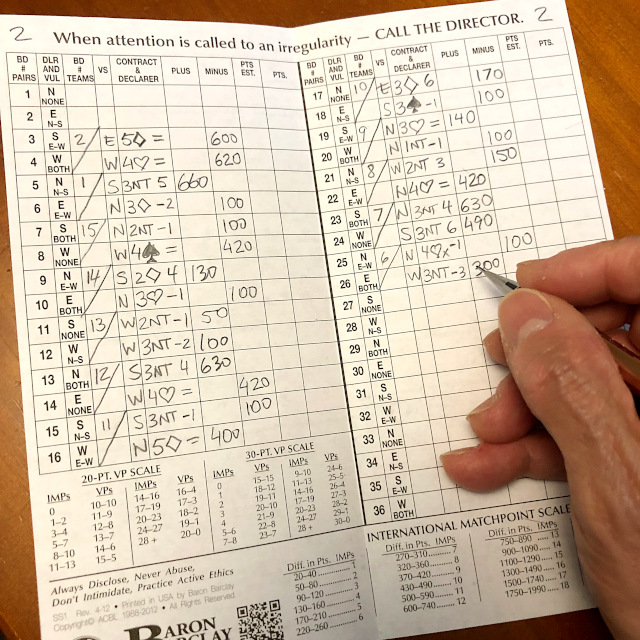|
Traveling Sheet
A traveling scoreslip (also called a traveler) is a form used for recording the results of each deal in a duplicate bridge tournament. In these tournaments, the four hands of each deal are placed into a board Board or Boards may refer to: Flat surface * Lumber, or other rigid material, milled or sawn flat ** Plank (wood) ** Cutting board ** Sounding board, of a musical instrument * Cardboard (paper product) * Paperboard * Fiberboard ** Hardboard, a ... so that the same deal can be played by different competitors. Each time the deal (or board) is played, the result is entered into the appropriate row of the traveling scoreslip, which is placed in a pocket in the board. At the end of the tournament, the traveling scoreslips are gathered and the tournament results calculated. The exact format of the traveling scoreslip varies but usually has the following data fields to be completed by competitors: * Board number * The cards held by each seat (North, West, East and South) – ... [...More Info...] [...Related Items...] OR: [Wikipedia] [Google] [Baidu] |
Form (document)
A form is a document which contains blank spaces (also named ''fields'' or ''placeholders'') in which one can write or select an option. Forms can be distributed to several signatories at once, or made available on demand. Before being filled out, each copy of a form is usually identical, except, possibly, for a serial number. A form allows an organisation to collect a uniform set of data from many parties in a consistent manner. Forms, when completed, vary in their purpose; for example, a form might be a statement, a request, or an order. A cheque may also be considered a form. In addition, there are several forms for taxes. An example is a tax return; filling one out is required in order for the amount of tax one owes to be determined. A form may also be a request for a tax refund. Forms may be filled out in duplicate (or ''triplicate'', meaning three times) when the information gathered on the form needs to be distributed to several departments within an organisation. This ... [...More Info...] [...Related Items...] OR: [Wikipedia] [Google] [Baidu] |
Duplicate Bridge
Duplicate bridge is a variation of contract bridge where the same set of bridge deals (i.e., the distribution of the 52 cards among the four hands) are played by different competitors, and scoring is based on relative performance. In this way, every hand, whether strong or weak, is played in competition with others playing identical cards, and the element of skill is heightened while that of chance is reduced. This stands in contrast to Bridge played without duplication, where each hand is freshly dealt and where scores may be more affected by chance in the short run. Four-way card holders known as Board (bridge), bridge boards are used to enable each player's hand to be preserved from table to table, and final scores are calculated by comparing each pair's result with others who played the same hand. In duplicate bridge, players normally play all the hands with the same partner, and compete either as a partnership (in a 'Pairs tournament') or on a team with one or more other p ... [...More Info...] [...Related Items...] OR: [Wikipedia] [Google] [Baidu] |
Board (bridge)
In duplicate bridge, a board is an item of equipment that holds one deal, or one deck of 52 cards distributed in four hands of 13 cards each. The design permits the entire deal of four hands to be passed, carried or stacked securely with the cards hidden from view in four pockets. This is required for in-person duplicate bridge tournaments, where the same deal is played several times and so the composition of each hand must be preserved during and after each play of each deal. When bridge is played online, the functions of the physical boards are replaced by the software. Each board is usually marked with the following information: board number – (from '1' to as high as '36') identifies the deal and helps to order the play of multiple deals; compass directions – used to match the four hands to the four players at a table; dealer – designates which player is the "dealer"; this designates the player who is to make the first call of the auction; vulnerability – often repre ... [...More Info...] [...Related Items...] OR: [Wikipedia] [Google] [Baidu] |
